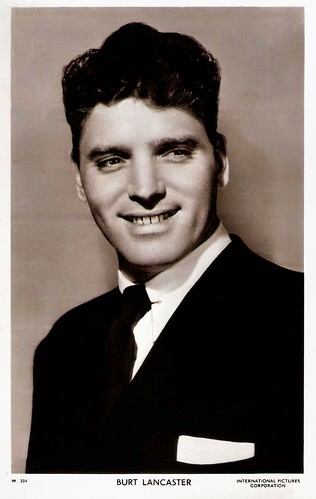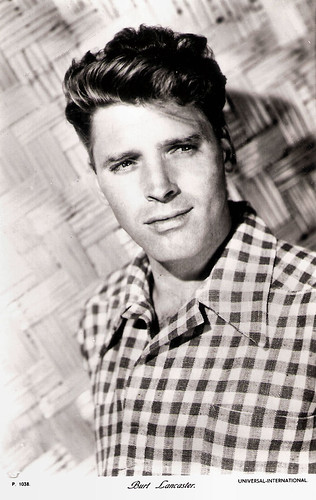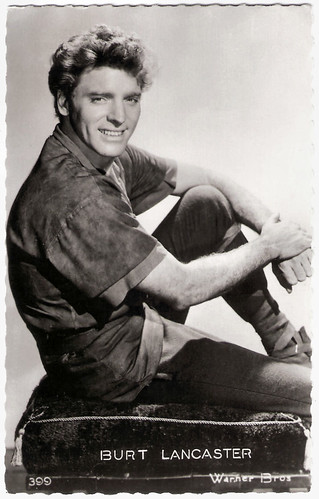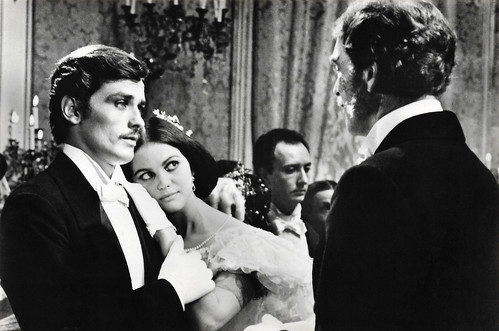
Vintage postcard. Photo: A.L. 'Whitey' Schafer.

French postcard in the Collection Magie Noireby Éditions Hazan, Paris, 1990, no. 6231. Burt Lancaster and Ava Gardner in The Killers (Robert Siodmak, 1946).

German postcard by Kunst und Bild, Berlin, no. A 338. Photo: Paramount. Publicity still for I Walk Alone (Byron Haskin, 1948).

Spanish postcard, no. 1218. Photo: Warner Bros.Burt Lancaster and Virginia Mayo in The Flame and the Arrow (Jacques Tourneur, 1950).

Swiss-German-British postcard by News Productions, Baulmes / Filmwelt Berlin, Bakede / News Productions, Stroud, no. 56551. Photo: Sam Shaw. Burt Lancaster on the Paris set of Trapeze (Carol Reed, 1956).

Vintage postcard by GM. Photo: Paramount.
Acrobat, nude model, and singing waiter
Burton Stephen Lancaster was born in East Harlem in New York City in 1914. He was one of the five children of Elizabeth (Roberts) and James Henry Lancaster, a postal clerk at Manhattan's General Post Office. All of his grandparents were immigrants from Northern Ireland. Burt was a tough street kid who took an early interest in gymnastics. Lancaster was accepted into New York University with an athletic scholarship but subsequently dropped out.
At the age of 19, Lancaster met Nick Cravat, with whom he continued to work throughout his life. Together they learned to act in local theatre productions and circus arts at Union Settlement, one of the city's oldest settlement houses. They formed the acrobat duo 'Lang and Cravat' and joined the Kay Brothers circus. In 1939, an injury forced Lancaster to give up the profession, with great regret.
He supported himself by working as a nude artist model by day and a singing waiter by night. In 1942, he joined the US Army during WW II and performed with the Twenty-First Special Services Division, organized to follow the troops on the ground and provide USO entertainment to keep up morale. He served with General Mark Clark's Fifth Army in Italy from 1943 to 1945.
After the war, he made his Broadway debut as Burton Lancaster in Harry Brown's wartime drama 'A Sound of Hunting', the source for the film Eight Iron Men (Edward Dmytryk, 1952). Though the production closed after 12 performances, Lancaster caught the eye of Hollywood agent Harold Hecht. Hecht provided Lancaster with an introduction to producer Hal Wallis.
Lancaster's debut was the Film Noir The Killers (Robert Siodmak, 1946) opposite Ava Gardner. Siodmak and cinematographer Elwood Bredell employed stark chiaroscuro lighting to offset Lancaster's angular face and chiselled physique. It made him an instant Hollywood star at the age of 32.

British postcard in the Picturegoer Series, London, no. W 304. Photo: International Pictures Corporation.

British postcard in The People series by Show Parade Picture Service, London, no. P. 1038. Photo: Universal International.

French postcard by Editions P.I., no. 399. Photo: Warner Bros. Publicity still for The Flame and the Arrow (Jacques Tourneur, 1950).

British postcard in the Picturegoer Series, no. D 79. Photo: Warner Bros. Publicity still for The Crimson Pirate (Robert Siodmak, 1952).

German postcard by Kunst und Bild, Berlin, no. A 1299. Photo: Hal Wallis / Paramount. Burt Lancaster in Come Back, Little Sheba (Daniel Mann, 1952).

German postcard by Franz Josef Rüdel, Filmpostkartenverlag, Hamburg-Bergedorf, no. 858. Photo: Columbia-Film. Publicity still for From Here to Eternity (Fred Zinnemann, 1953).

German postcard by Ufa, Berlin-Tempelhof, no. CK-156. Photo: Sam Lévin.
His own production company
After his sensational debut, the tall, muscular Lancaster appeared in two more films the following year. He traded on his tough-guy image in Jules Dassin's Brute Force (1947) and I Walk Alone (Byron Haskin, 1948). He reunited with Robert Siodmak for another excellent Film Noir, Criss Cross (1949). He varied the image slightly, playing Barbara Stanwyck's cheating husband in Sorry, Wrong Number (Anatole Litvak, 1948) and Edward G. Robinson's conscience-bound son in All My Sons (Irving Reis, 1948), a personal project for which he took a $50,000 salary cut. Lancaster was a self-taught actor who learned the business as he went along.
Burt Lancaster impressed film audiences with his acrobatic prowess the Technicolor Swashbucklers The Flame and the Arrow (Jacques Tourneur, 1950), and The Crimson Pirate (Robert Siodmak, 1952). The films became his first major box-office successes. His friend from his circus years, Nick Cravat, played a key supporting role in both films. Lancaster played one of his best-remembered roles with Deborah Kerr in From Here to Eternity (Fred Zinnemann, 1953). Iconic is the scene in which he and Kerr make love on a Hawaiian beach amid the crashing waves.
In 1953, Lancaster started going in new directions, he later told film critic Roger Ebert: “That was when I went from From Here to Eternity to Come Back, Little Sheba. I always tried to do things that would expand me as an actor. You find out people don’t want you to do that. ‘Make another “Vera Cruz”,’ they say. ‘Make another picture like ‘Trapeze.’ Don’t do ‘The Leopard,’ for God’s sake’!” He was nominated for an Academy Award for his role in From Here to Eternity (Fred Zinnemann, 1953). Lancaster won the 1960 Academy Award for Best Actor, a Golden Globe Award, and the New York Film Critics Award for his performance playing the corrupt evangelist in Elmer Gantry (Richard Brooks, 1960).
Burt Lancaster set up his own production company with Harold Hecht and James Hill, to direct his career. Their production company, Hecht-Hill-Lancaster, produced such films as the Oscar winner Marty (Paddy Chayefsky, 1955), Trapeze (Carol Reed, 1956), Sweet Smell of Success (Alexander Mackendrick, 1957), and Separate Tables (Delbert Mann, 1958). Lancaster realised a long-held dream and directed his own film, The Kentuckian (1955). Reviews were negative, however, and he did not return to the director's chair for another two decades. In 1965, United Artists made a settlement with Lancaster to end its association with Hecht-Hill-Lancaster, which had financially floundered in the late 1950s due to a few flops and exorbitant spending and wound up operations in 1959.
His films often reflected his liberal political beliefs. In 1947 he signed a letter deploring the anti-communist witch hunts in Hollywood, and he was nearly blacklisted due to his political beliefs. The FBI kept a file detailing his activities. In 1963, he was one of the Hollywood stars, who participated in Martin Luther King's March on Washington. Later, Lancaster appeared prominently on President Richard Nixon's 'List of Enemies' due to his support for Senator George McGovern in the 1972 presidential election. In 1985, Lancaster joined the fight against AIDS after his close friend, Rock Hudson, contracted the disease. He campaigned for Michael Dukakis in the 1988 presidential election.

Dutch postcard by Uitg. Takken, Utrecht, no. AX 3045.

German postcard by Franz Josef Rüdel Filmpostkarten-Verlag, Hamburg-Bergedorf, no. W 1552. Photo: Warner Bros. Publicity still for South Sea Woman (Arthur Lubin, 1953).

German postcard by Kolibri-Verlag, Minden/Westf. Photo: Warner Bros. Burt Lancaster in His Majesty O'Keefe (Byron Haskin, 1954). Collection: Geoffrey Donaldson Institute.

Spanish postcard by H. Burt Lancaster and Joan Rice in His Majesty O'Keefe (Byron Haskin, 1954). On the flipside is written that the actress is Ronda Fleming (sic).

Romanian postcard by Casa Filmului Acin, no. 39. Photo: MGM. Gary Cooper, Sara Montiel, Denise Darcel and Burt Lancaster in Vera Cruz (Robert Aldrich, 1954).

German postcard by Kunst und Bild, Berlin, no. T 828. Photo: Warner Bros.

German postcard by Kunst und Bild, Berlin, no. C.D. 10.
Heart attack
During the latter part of his career, Burt Lancaster left adventure and acrobatic films behind and portrayed more distinguished characters. This period brought him to work on several European productions. Italian director Luchino Visconti wanted to cast Laurence Olivier in the title role of the Italian prince in Il gattopardo/The Leopard (1963) opposite Alain Delon and Claudia Cardinale, but his producer overruled him. The producer insisted on a box office star to justify the lavish production's high budget and essentially forced Visconti to accept Lancaster. Lancaster delivered one of the strongest performances of his career, and the film was a huge success in Europe. Visconti directed him again in Gruppo di famiglia in un interno/Conversation Piece (Luchino Visconti, 1974) with Silvana Mangano and Helmut Berger. In this film, Lancaster plays a reclusive professor who is brought face to face with his latent homosexuality.
Lancaster sought demanding roles, and if he liked a part or a director, he was prepared to work for much lower pay than he might have earned elsewhere. He even helped to finance movies whose artistic value he believed in. He also mentored directors such as Sydney Pollack and John Frankenheimer and appeared in several television films. He also appeared in European features like Novecento/1900 (Bernardo Bertolucci, 1976) as Robert De Niro's autocratic grandfather, and as an ageing gangster in Atlantic City (Louis Malle, 1980), which earned him an Oscar nomination.
He tried to raise financing for four years for Hector Babenco's film Kiss of the Spider Woman (1985), based on the novel by Manuel Puig, after Babenco gave him the novel in 1981 at the NY Film Critics Society Ceremony. Lancaster was to have played the role of Molina, the gay hairdresser who shares a cell with Valentin, a political prisoner. However, Lancaster had heart attacks in 1981 and 1983, and subsequently a quadruple-bypass operation, and at the age of 70, he was essentially uninsurable. The film was later made with William Hurt, who won the Best Actor Oscar as Molina.
In the 1980s Burt Lancaster appeared as a supporting player in several films, such as an American general in the Italian war drama La pelle/The Skin (Liliana Cavani, 1981), an astronomy-obsessed Texas oilman in Bill Forsythe's wry comedy Local Hero (1983). Lancaster's last feature film was Field of Dreams (Phil Alden Robinson, 1989) with Kevin Costner.
His acting career ended after he suffered a stroke in 1990 which left him partly paralysed and largely unable to speak. At 80, Burt Lancaster died in his Century City apartment in Los Angeles in 1994, the very same year as his long-time friend and circus partner Nick Cravat. Lancaster was married three times. He was married to acrobat June Ernst from 1935 to 1946, and to Norma Anderson from 1946 to 1969. His third marriage, to Susan Martin, was from September 1990 until he died in 1994. He and his second wife Norma had five children: James Stephen 'Jimmy' (1946), William 'Billy' (1947), Susan Elizabeth (1949), Joanna Mari (1951), and Sighle (1954).

French postcard by Editions Paris-Musées. Collection: Dominique Lebrun. Corinne Calvet and Burt Lancaster in Rope of Sand (William Dieterle, 1949). Sent by mail in 2009.

Yugoslavian postcard by IOM, Beograd. Photo: Sedmo Silo. Deborah Kerr and Burt Lancaster in From Here to Eternity (Fred Zinnemann, 1953).

French postcard in the Collection Magie Noire by Éditions Hazan, Paris, 1995, no. 6478. Burt Lancaster and Deborah Kerr in From Here to Eternity (Fred Zinnemann, 1953).

German postcard by Kolibri-Verlag, G.m.b.H., Minden-Westf., no. 2180. Photo: Production Hecht-Lancaster. Burt Lancaster, Gina Lollobrigida and Tony Curtis in Trapeze (Carol Reed, 1956).

Italian postcard by Bromofoto, no. 957. Photo: Columbia C.E.I.A.D.

American postcard by Fotofolio, NY, NY, no. F 232. Photo: Phil Stern. Burt Lancaster in Separate Tables (Delbert Mann, 1958).

Czech collector card by Pressfoto, Praha, no. S 37.8. Burt Lancaster in Birdman of Alcatraz (John Frankenheimer, 1962).

Czech postcard by UPTF / Pressfoto, Praha (Prague), no. C 198, 1965. Photo: G.B. Poletto. Alain Delon, Claudia Cardinale and Burt Lancaster in Il Gattopardo/The Leopard (Luchino Visconti, 1963).

Vintage card. Burt Lancaster in The Professionals (Richard Brooks, 1966).

Romanian postcard by Casa Filmului Acin, no. 523. Burt Lancaster in Ulzana's Raid (Robert Aldrich, 1972).

Vintage photo.
Sources: Roger Ebert (Roger Ebert.com), Richard Harland Smith (TCM - Page now defunct), Jason Ankeny (AllMovie - Page now defunct), Tony Fontana (IMDb), Wikipedia, and IMDb.
1 comment:
Loved him in many films, including The Leopard, BUT he was simply astonishing in Elmer Gantry and From Here to Eternity.
Post a Comment